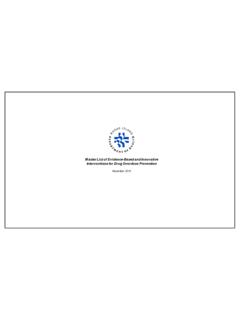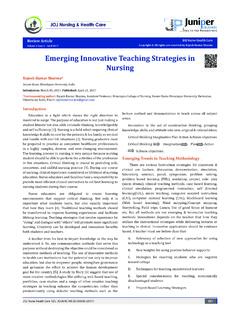Transcription of Defining and Solving the Organizational Structure Problems ...
1 International Journal of Scientific and Research Publications, Volume 3, Issue 10, October 2013 1 ISSN 2250-3153 Defining and Solving the Organizational Structure Problems to Improve the Performanceof Ministry of State for Environmental Affairs - Egypt Nedal M. Elsaid1, Ahmed E. Okasha2& Abdalla A. Abdelghaly3 1. is currently pursuing Doctor of Philosophy (Ph. D.) degree in Euro Mediterranean Studies Department, Faculty of Economics and Political Science, Cairo University, Egypt. 2. Dr. AhmedE. Okasha is lecturer in Social-Science Computing Department, Faculty of Economics and Political Science, Cairo University, Egypt. 3. Dr. Abdalla A. Abdelghaly is Professor in Statistics Department, Faculty of Economics and Political Science, Cairo University, Egypt. Abstract - The structured problem Solving is important methodology in improve the organization performance. This study is aiming to provide more insight that determines the Organizational Problems , solutions for the ministry of state for environmental affairs which it is one of the most critical issues effect the administration fields.
2 Firstly, we discuss the concept of organization structured and organization structured types. Secondly, we focus on the signs of poor organizations structured which it indicate that the organization is deeply need to solve the mentioned problem . Thirdly, we discuss the base of structured problem Solving is the Deming circle: And introduce the Bank's 6 steps process of the problem Solving . then discuss the important of a create and maintain healthy organization structured manner using team in problem Solving . Finally, we discuss the arguments against using a structured problem Solving . Keywords: Organizational Structure , OS types, Poor OS, Healthy OS, OS arguments, OS procedures. 1. Introduction rganizational Structure refers to the way that an organization arranges people and jobs so that its work can be performed and its goals can be met. When a work group is very small, and face-to-face communication is frequent, formal Structure may be unnecessary, but in a larger organization decisions have to be made about the delegation of various tasks.
3 Thus, procedures are established that assign responsibilities for various functions. It is these decisions that determine the Organizational Structure [08]. In an organization of any size or complexity, employees' responsibilities typically are defined by what they do, who they report to, and for managers, who reports to them. Over time these definitions are assigned to positions in the organization rather than to specific individuals. The relationships among these positions are illustrated graphically in an Organizational chart. The best Organizational Structure for any organization depends on many factors including the work it does, its size in terms of employees, revenue, the geographic dispersion of its facilities, and the range of its businesses[05]. The Organizational Structure consists of activities such as task allocation, coordination and supervision, which are directed towards the achievement of Organizational aims. It can also be considered as the viewing glass or perspective through which individuals see their organization and its environment[16].
4 The Organizational Structure affects Organizational action in two ways. First, it provides the foundation on which standard operating procedures and routines rest. Second, it determines which individuals get to participate in which decision-making processes, and thus to what extent their views shape the organization s actions [14]. 2. Organizational Structure types Functional Structure Employees within the functional divisions of an organization tend to perform a specialized set of tasks. This leads to operational efficiencies within that group. However it could also lead to a lack of communication between the functional groups within an organization, making the organization slow and inflexible[08] . Generally functional organization is best suited as a producer of standardized goods and services at large volume and low cost. Coordination and specialization of tasks are centralized in a functional Structure , which makes producing a limited O International Journal of Scientific and Research Publications, Volume 3, Issue 10, October 2013 2 ISSN 2250-3153 amount of products or services efficient and predictable.
5 Moreover, efficiencies can further be realized as functional organizations integrate their activities vertically so that products are sold and distributed quickly and at low cost. For instance, a small business could make components used in production of its products instead of buying them[03]. A disadvantage of functional groupings is that people with the same skills and knowledge may develop a narrow departmental focus and have difficulty appreciating any other view of what is important to the organization; in this case, Organizational goals may be sacrificed in favor of departmental goals. In addition, coordination of work across functional boundaries can become a difficult management challenge, especially as the organization grows in size and spreads to multiple geographical locations[02]. Divisional Structure Also called a "product Structure ", the divisional Structure groups each Organizational function into a division.
6 Each division within a divisional Structure contains all the necessary resources and functions within it[09]. Divisions can be categorized from different points of view. One might make distinctions on a geographical basis (a US division and an EU division, for example) or on product/service basis (different products for different customers: households or companies). In another example, an automobile company with a divisional Structure might have one division for SUVs(Sport Utility Vehicle), another division for subcompact cars, and another division for sedans. Each division may have its own sales, engineering and marketing departments. Organizations that are spread over a wide area may find advantages in organizing along geographic lines so that all the activities performed in a region are managed together. In a large organization, simple physical separation makes centralized coordination more difficult[06].
7 Also, important characteristics of a region may make it advantageous to promote a local focus. For example, marketing a product in Western Europe may have different requirements than marketing the same product in Southeast Asia. Companies that market products globally sometimes adopt a geographic Structure . In addition, experience gained in a regional division is often excellent training for management at higher levels. Large, diversified companies are often organized according to product. All the activities necessary to produce and market a product or group of similar products are grouped together. In such an arrangement, the top manager of the product group typically has considerable autonomy over the operation. The advantage of this type of Structure is that the personnel in the group can focus on the particular needs of their product line and become experts in its development, production, and distribution. A disadvantage, at least in terms of larger organizations, is the duplication of resources[08].
8 Each product group requires most of the functional areas such as finance, marketing, production, and other functions. The top leadership of the organization must decide how much redundancy it can afford [05]. Matrix Structure The matrix Structure groups employees by both function and product. This Structure can combine the best of both separate structures. A matrix organization frequently uses teams of employees to accomplish work, in order to take advantage of the strengths, as well as make up for the weaknesses, of functional and decentralized forms[09]. An example would be a company that produces two products, "product a" and "product b". Using the matrix Structure , this company would organize functions within the company as follows: "product a" sales department, "product a" customer service department, "product a" accounting, "product b" sales department, "product b" customer service department, "product b" accounting department.
9 Matrix Structure is amongst the purest of Organizational structures, a simple lattice emulating order and regularity demonstrated in nature. Because the matrix Structure is often used in organizations using the line-and-staff setup, it is also fairly centralized. However, the chain of command is different in that an employee can report to one or more managers, but one manager typically has more authority over the employee than the other manager(s). Within the project or team unit, decision making can occur faster than in a line-and-staff Structure , but probably not as quickly as in a line Structure [05]. Weak/Functional Matrix: A project manager with only limited authority is assigned to oversee the cross functional aspects of the project. The functional managers maintain control over their resources and project areas[03]. Balanced/Functional Matrix: A project manager is assigned to oversee the project. Power is shared equally between the project manager and the functional managers.
10 It brings the best aspects of functional and projectized organizations. However, this is the most difficult system to maintain as the sharing of power is a delicate proposition[03]. International Journal of Scientific and Research Publications, Volume 3, Issue 10, October 2013 3 ISSN 2250-3153 Strong/Project Matrix: A project manager is primarily responsible for the project. Functional managers provide technical expertise and assign resources as needed[03]. 3. Signs of Poor Organizational Structure The Organizational Structure of a business is the framework that facilitates communications and efficient work processes. When business Problems emerge, signs often exist within the design or components of the Organizational Structure . In some cases, these signs can be early indicators of significant Problems that need to be addressed[20]. Low Productivity Productivity is a key metric for almost every business. Low productivity levels can indicate a problem in an organization s Structure .


















